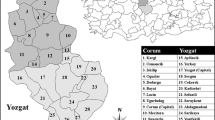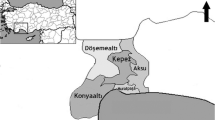Abstract
In this study, a total of 5,094 ticks found on humans were examined in terms of species, development stage, gender, host features and seasonality for a year period. Of these ticks 17 were argasid and 5,077 were ixodid. Predominantly species of the ixodid genera Hyalomma, Dermacentor, Rhipicephalus and Haemaphysalis were found on humans in Ankara (Anatolia). Most abundant were Hyalomma nymphs (29.8%) and adults (28.2%). Primary factors in terms of tick bite risk were region, habitat and season.
Similar content being viewed by others
References
Apanaskevich DA (2003) To diagnostics of Hyalomma aegyptium (Acari: Ixodidae). Parazitologiya 37:47–59
Apanaskevich DA (2004) Host-parasite relationships of the genus Hyalomma Koch (Acari, Ixodidae) and their connection with microevolutionary processes (in Russian). Parazitologiya 38:515–523
Aydin L, Bakirci S (2007) Geographical distribution of ticks in Turkey. Parasitol Res 101(2):163–166
Barker SC, Murrell A (2004) Systematics and evolution of ticks with a list of valid genus and species names. Parasitology 129(Suppl):15–36
Cicek H (2004) Epizootiological studies on Haemaphysalis ticks in Ankara province, Turkey. Turk J Vet Anim Sci 28(1):107–113
Despommier DD, Gwadz RW, Hotez PJ, Knirsch CA (2000) Parasitic diseases. Apple Trees Prod, New York
Ergonul O (2006) Crimean-Congo haemorrhagic fever. Lancet Infect Dis 6(4):203–214
Estrada-Peña A, Jongejan F (1999) Ticks feeding on humans: a review of records on human-biting Ixodoidea with special reference to pathogen transmission. Exp Appl Acarol 23:685–715
Estrada-Peña A, Bouattour A, Camicas JL, Walker AR (2004) Ticks of domestic animals in the Mediterranean region. A guide of identification of species, University of Zaragoza Press, Zaragoza
Fourie LJ, Horak IG, van Zyl JM (1991) Sites of attachment and intraspecific infestation densities of the brown paralysis tick (Rhipicephalus punctatus) on Angora goats. Exp and Appl Acarol 12(3–4):243–249
Hoogstraal H (1979) The epidemiology of tick-borne Crimean-Congo hemorrhagic fever in Asia, Europe, and Africa. J Med Entomol 15(4):307–417
Jongejan F, Uilenberg G (2004) The global importance of ticks. Parasitology 129(Suppl):3–14
Karaer Z (1981) Ankara ili ve civarinda Hyalomma detritum (Schulze, 1919)’un biyo-ekolojisi uzerinde arastirmalar. Dissertation, Ankara Universitesi
Krauss H, Weber A, Appel M, Enders B, von Graevenitz A, Isenberg HD et al (2004) Zoonosen, von Tier zu Menschen übertragbare Infektionskrankheiten. 3th Auflage. Deutscher Ärzte-Verlag, Köln, p 605
Labuda M, Nuttall PA (2004) Tick-borne viruses. Parasitology 129(Suppl):S221–S245
Petney TN, Al-Yaman F (1985) Attachment sites of the tortoise tick Hyalomma aegyptium in relation to tick density and physical conditions of the host. J Parasitol 71:287–289
Qiu W, Dykhuizen DE, Acosta MS, Luft BJ (2002) Geographic uniformity of the Lyme disease spirochete (Borrelia burgdorferi) and its shared history with tick vector (Ixodes scapularis) in the Northeastern United States. Genetics 160:833–849
Randolph SE (2008) How does tick ecology determine risk? http://www.lymediseaseaction.org.uk/conf2008/randolph.pdf. Accessed 26 June 2007
Rees DJ, Dioli M, Kirkendalla LR (2003) Molecules and morphology: evidence for cryptic hybridization in African Hyalomma (Acari: Ixodidae). Mol Phyl Evol 27:131–142
Siroky P, Petrzelkova KJ, Kamler M, Mihalca AD, Modry D (2006) Hyalomma aegyptium as dominant tick in tortoises of the genus Testudo in Balkan countries, with notes on its host preferences. Exp Appl Acarol 40:279–290
Sonenshine DE (1993) Biology of ticks. Oxford University Press, New York
Urquhart GM, Armour J, Duncan JL, Dunn AM, Jennings FW (1987) Veterinary parasitology. Churchill Livingstone Inc., New York
Valenzuela JG (2004) Exploring tick saliva: from biochemistry to ‘sialomes’ and functional genomics. Parasitol 129:83–94
Vatansever Z (2008) Vektor kenelerin ekolojisi. Kene Kaynakli Enfeksiyonlar, Medsan, Ankara
Vatansever Z, Gargili A, Aysul NS, Sengoz G, Estrada-Peña A (2008) Ticks biting humans in the urban area of Istanbul. Parasitol Res 102:551–553
Walker AR, Bouattour A, Camicas JL, Estrada-Pena A, Horak IG, Latif AA, Pegram RG, Preston PM (2003) Ticks of domestic animals in Africa: a guide to identification of species. Bioscience Reports, Edinburgh
Author information
Authors and Affiliations
Corresponding author
Rights and permissions
About this article
Cite this article
Karaer, Z., Guven, E., Nalbantoglu, S. et al. Ticks on humans in Ankara, Turkey. Exp Appl Acarol 54, 85–91 (2011). https://doi.org/10.1007/s10493-010-9417-1
Received:
Accepted:
Published:
Issue Date:
DOI: https://doi.org/10.1007/s10493-010-9417-1




